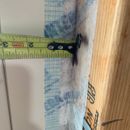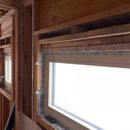Insulation on interior side of windows
I am getting ready to install my interior air barrier (Siga Majrex) but I need to determine how I am going to deal a few details around my windows before doing so. I have attached a couple of pictures of one of the window that shows each of the issues I am dealing with. First there is the empty space between the header and the inside edge of the 2×6 studs. Depending on whether my framer used a triple 2x or a double LVL, the space will vary between 1″ and 2″. I was planning on using foil faced polyiso to make the headers flush with the studs and then cover with the Majrex. Next I have the pockets created with the cripples between the headers and the window head. Some of those are on the small side so I was going to just using Rockwool to insulate them. Finally if have the windows jams and head. The windows will have drywall returns in those areas, the sill will be finished with wood. The gap between the edge of the tape on the window face and the RO varies anywhere from 3/4″ to 1 1/2″. My drywall is 5/8″ so I need to pack out these areas so the tape will not be visible. I figured I would also use foil faced polyiso in this area which would reduce the thermal bridging and would be easier to install than wood blocking or plywood to fill those gaps. In terms of sequence for this area, I would tape the Majrex to the window first and then add the polyiso using cap nails otherwise I will have another tape edge on the window face to deal with.
A few other details that might be relevant to this discussion:
1) the exterior insulation is 3″ of ComfortBoard 80;
2) the gap between the RO and window frame is insulated with sheeps’ wool;
3) the windows were installed flush to the sheathing, taped inside and out.
Thoughts?
GBA Detail Library
A collection of one thousand construction details organized by climate and house part











Replies
Jonathan,
I filled my window headers with whatever foam I had lying around (mostly was layers of 1/2 foil faced polyiso). Over such a small area foil facing or not doesn't matter.
For the sides of the window rough openings, those typically just get packed out with strips of left over plywood and shims. For the larger gap, a layer of foam underneath doesn't hurt, just put some 1/2" plywood on top for the drywall screws to bite into.
Thanks Akos. I am going to work on that window this week and will post back.
HI Jonathan -
Hardest part of the window install is getting the sill airtight without impeding bulk water drainage.
Is your rough opening sill flashing sloped or back-dammed?
Best practice is one or the other.
Best - Peter
Hi Peter,
It is sloped. We placed a piece of beveled cedar on the sill then taped with Extoseal. The picture shows a 6" nominal piece of cedar but after the first few windows we decided to rip the cedar down to the width of the window frame to make it easier when installing the finished interior window sill. After the windows were installed, I taped the outside with ProClima's vapor open tape. On the inside, I used ProClima's vapor closed tape. For the operable windows that we installed using screws, I was able to attach the tape to the frame first which avoids the whole tape seam on the face issue and is quicker and easier than taping afterwards in my opinion. I happened to order the windows with the aluminum cladding cut back which made it much easier to tape the exterior and to affix the trim. The trim has head flashing, first half of the install without end dams, the second with the end dams (thanks Malcolm). The sills are Azek that we sloped 10 degrees and added a kerf cut on the underside.
Thanks,
Jonathan